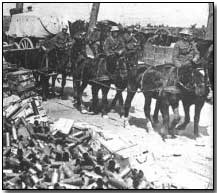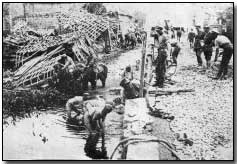At 5.30 on the morning of April 9, 1917, Easter Monday, the creeping artillery barrage began to move steadily towards the Germans. Behind it advanced 20,000 soldiers of the first attacking wave of the four Canadian divisions, a score of battalions in line abreast, leading the assault in a driving north-west wind that swept the mangled countryside with sleet and snow. Guided by paint-marked stakes, the leading infantry companies crossed the devastation of No Man's Land, picking their way through shell-holes and shattered trenches. They were heavily laden. Each soldier carried at least 32 kilograms of equipment, plus, some say, a similar weight of the all-pervasive mud on uniform and equipment. This burden made climbing in and out of the numerous trenches and craters particularly difficult.










There was some hand-to-hand fighting, but the greatest resistance, and heavy Canadian losses, came from the strongly-emplaced machine-guns in the German intermediate line. Overcoming this resistance, three of the four divisions captured their part of the Ridge by midday, right on schedule. In the final stage, the 2nd Canadian Division was assisted by the British 13th Brigade, which fell under its command for the operation.
The 4th Canadian Division's principal objective was Hill 145, the highest and most important feature of the whole Ridge. Once taken, its summit would give the Canadians a commanding view of German rearward defences in the Douai Plain as well as those remaining on the Ridge itself.
Because of its importance, the Germans had fortified Hill 145 with well-wired trenches and a series of deep dug-outs beneath its rear slope. The brigades of the 4th Division were hampered by fire from the Pimple, the other prominent height, which inflicted costly losses on the advancing waves of infantry. Renewed attacks were mounted using troops that were originally scheduled to attack the Pimple. Finally, in the afternoon of April 10, a fresh assault by a relieving brigade cleared the summit of Hill 145 and thus placed the whole of Vimy Ridge in Canadian hands. Two days later, units of the 10th Canadian Brigade successfully stormed the Pimple. By that time, the enemy had accepted the loss of Vimy Ridge as permanent and had pulled back more than three kilometres.

Vimy Ridge marked the only significant success of the Allied spring offensive of 1917. But though they had won a great tactical victory, the Canadians were unable to exploit their success quickly with a breakthrough, mainly because their artillery had bogged down and was unable to move up with them through the muddy, shell-torn ground. Instead, some Canadian artillerymen took over captured German guns which they had earlier been trained to fire.
The Canadian achievement in capturing Vimy Ridge owed its success to sound and meticulous planning and thorough preparation, all of which was aimed at minimizing casualties. But it was the splendid fighting qualities and devotion to duty of Canadian officers and soldiers on the battlefield that were decisive. Most of them citizen-soldiers, they performed like professionals.
Canadians attacked German machine-guns, the greatest obstacles to their advance, with great courage. They saved many comrades' lives as a result. Four won the Victoria Cross for their bravery in such dangerous exploits. Of these, three were earned on the opening day of the battle.

General Sir Arthur Currie (1875-1933) became brigadier-general in the battle of St. Julien in 1915, and in 1917 was given charge of the whole Canadian Corps through the final victory sweep of 1918.
Private William Milne of the 16th Battalion won the VC when he crawled up to a German machine-gun that had been firing on the advancing Canadians, bombed its crew and captured the gun. Later, he stalked a second machine-gun, killing its crew and capturing it, but was himself killed shortly thereafter. The whereabouts of Private Milne's grave is unknown.
Lance-Sergeant Ellis Sifton of the 18th Battalion charged a machine-gun post single-handed, leaping into the trench where it was concealed and killing its crew. Soon after, he was met by a small party of Germans who were advancing through the trench. He managed to hold them off until his comrades arrived, but then one of his victims, gasping a last breath of life, fired upon him.
During the fight for Hill 145, Captain Thain MacDowell of the 38th Battalion entered an enemy dug-out, where he tricked 77 Prussian Guards into surrendering and captured two machine-guns by pretending he had a large force behind him. His large force consisted of two soldiers. MacDowell had earned the Distinguished Service Order on the Somme.
On April 10, Private John Pattison of the 50th Battalion jumped from shell-hole to shell-hole until, 30 metres from an enemy machine-gun, he was in range to bomb its crew. He then rushed forward to bayonet the remaining five gunners. Pattison was killed two months later.

Of the four Vimy VCs, only Captain MacDowell survived the War.
At Vimy, the Canadian Corps had captured more ground, more prisoners and more guns than any previous British offensive in two-and-a-half years of war. It was one of the most complete and decisive engagements of the Great War and the greatest Allied victory up to that time. The Canadians had demonstrated they were one of the outstanding formations on the Western Front and masters of offensive warfare.
Though the victory at Vimy came swiftly, it did not come without cost. There were 3,598 dead out of 10,602 Canadian casualties. Battalions in the first waves of the assault suffered grievously. No level of casualties could ever be called "acceptable", but those at Vimy were lower than the terrible norm of many major assaults on the Western Front. They were also far lighter than those of any previous offensive at the Ridge. Earlier French, British and German struggles there had cost at least 200,000 casualties. Care in planning by the Corps Commander, Sir Julian Byng, and his right-hand man, Arthur Currie, kept Canadian casualties down.

The Canadian success at Vimy marked a profound turning-point for the Allies. A year-and-a-half later, the Great War was over. The Canadian record, crowned by the achievements at Vimy, won for Canada a separate signature on the Versailles Peace Treaty ending the War. Back home, the victory at Vimy, won by troops from every part of the country, helped unite many Canadians in pride at the courage of their citizen-soldiers, and established a feeling of real nationhood.
Brigadier-General Alexander Ross had commanded the 28th (North-West) Battalion at Vimy. Later, as president of the Canadian Legion, he proposed the first veterans' post-war pilgrimage to the new Vimy Memorial in 1936. He said of the battle:
"It was Canada from the Atlantic to the Pacific on parade. I thought then ... that in those few minutes I witnessed the birth of a nation."

